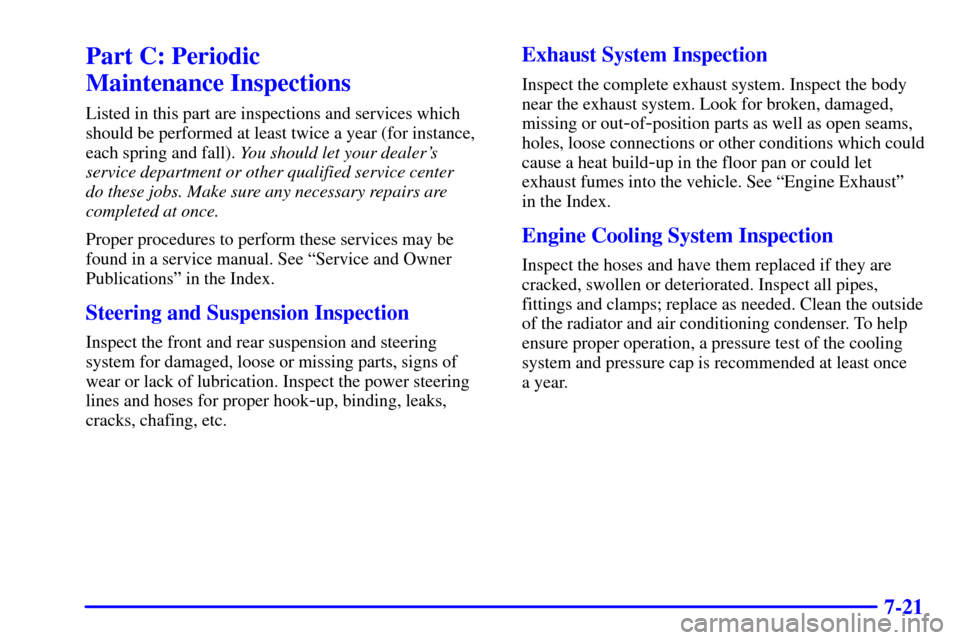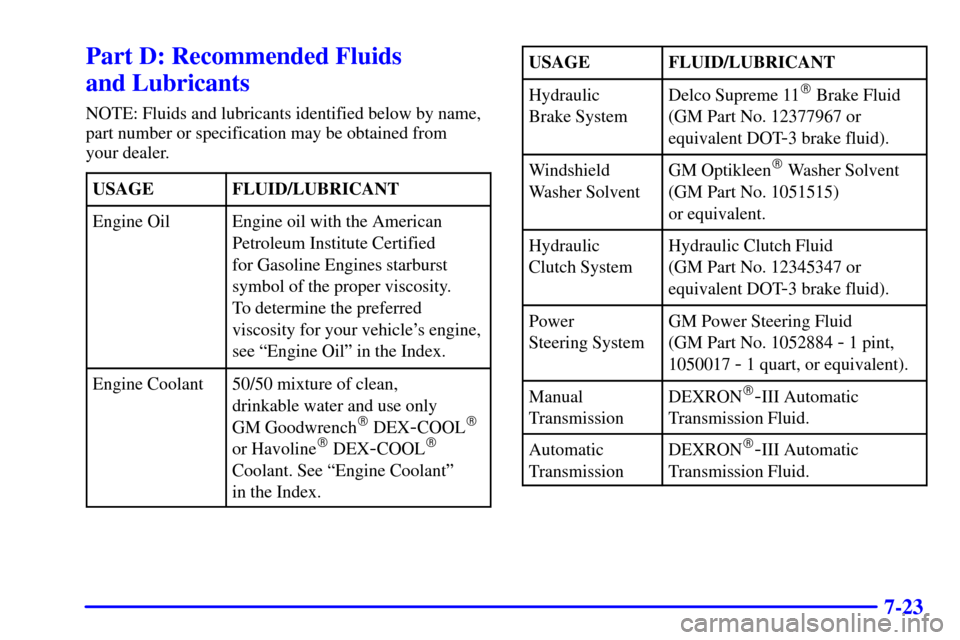Page 284 of 363
6-30
Radiator Pressure Cap
The radiator pressure cap is located toward the front of
the engine compartment near the battery. See ªEngine
Compartment Overviewº in the Index for more
information on location.
NOTICE:
Your radiator cap is an 18 psi (124 kPa)
pressure
-type cap and must be tightly installed to
prevent coolant loss and possible engine damage
from overheating. Be sure the arrows on the cap
line up with the overflow tube on the radiator
filler neck. See ªEngine Compartment Overviewº
in the Index for more information on location.
Power Steering Fluid
The power steering fluid
reservoir is located toward
the front of the engine, on
the driver's side. See
ªEngine Compartment
Overviewº in the Index for
more information
on location.
Page 285 of 363

6-31 When to Check Power Steering Fluid
It is not necessary to regularly check power steering fluid
unless you suspect there is a leak in the system or you hear
an unusual noise. A fluid loss in this system could indicate
a problem. Have the system inspected and repaired.
How to Check Power Steering Fluid
Turn the key off, let the engine compartment cool down,
wipe the cap and the top of the reservoir clean, then
unscrew the cap and wipe the dipstick with a clean rag.
Replace the cap and completely tighten it. Then remove
the cap again and look at the fluid level on the dipstick.
�When the engine compartment is hot, the level
should be at the H (hot) mark.
�When the engine compartment is cool, the level
should be at the C (cold) mark.
If necessary, add only enough fluid to bring the level up
to the mark.
What to Use
To determine what kind of fluid to use, see
ªRecommended Fluids and Lubricantsº in the Index.
Always use the proper fluid. Failure to use the proper
fluid can cause leaks and damage hoses and seals.
Page 318 of 363
6-64
Main Fuse Block
Fuse Usage
STOP/HAZARD Hazard Flashers, Brake
Switch Assembly
TURN B/U Traction Control/Second
-Gear
Start Switch, Back
-Up Lamp
Switch, Turn Flasher, Daytime
Running Lamps (DRL) ModuleFuse Usage
STG
WHL CNTRLSteering Wheel Controls
RADIO ACCY Delco Monsoon Radio Amplifier,
Remote CD Player (Trunk)
TAIL LPS Daytime Running Lamps (DRL)
Module, Headlamp Switch
HVAC HVAC Selector Switch,
Rear Defogger Switch/Timer
PWR ACCY Parking Lamp Relay, Hatch
Release Relay, Power Mirror
Switch, Radio, Shock Sensor,
Instrument Cluster
COURTESY Body Control Module (BCM)
GAUGES Body Control Module (BCM),
Brake
-Transmission Shift
Interlock (BTSI), Instrument
Cluster, Daytime Running
Lamps (DRL) Module
AIR BAG Air Bag System
Page 319 of 363
6-65
Fuse Usage
CIG/ACCY Cigarette Lighter, Data Link
Connector (DLC)
DEFOG/SEATS Rear Defogger Switch/Timer,
Power Seats
IGN Aftermarket Use Only
STG
WHL CNTRLSteering Wheel
Controls Illumination
WIPER/WASH Wiper Motor Assembly,
Wiper/Washer Switch
BATT Aftermarket Use Only
WINDOWS Power Windows Switch (RH, LH),
Express
-Down Module,
Convertible Top SwitchFuse Usage
IP DIMMER Door Illumination Lamp (LH, RH),
Headlamp Switch, Fog Lamp
Switch, Instrument Cluster, HVAC
Control Assembly, PRNDL
Illumination Lamp, Ashtray Lamp,
Radio, Rear Window Defogger
Switch/Timer, Traction Control
(ASR)/Second
-Gear Start Switch,
Convertible Top Switch
ACCY Aftermarket Use Only
RADIO Body Control Module (BCM),
Radio, Amplifier, Steering Wheel
Controls
-Radio
Page 345 of 363

7-21
Part C: Periodic
Maintenance Inspections
Listed in this part are inspections and services which
should be performed at least twice a year (for instance,
each spring and fall). You should let your dealer's
service department or other qualified service center
do these jobs. Make sure any necessary repairs are
completed at once.
Proper procedures to perform these services may be
found in a service manual. See ªService and Owner
Publicationsº in the Index.
Steering and Suspension Inspection
Inspect the front and rear suspension and steering
system for damaged, loose or missing parts, signs of
wear or lack of lubrication. Inspect the power steering
lines and hoses for proper hook
-up, binding, leaks,
cracks, chafing, etc.
Exhaust System Inspection
Inspect the complete exhaust system. Inspect the body
near the exhaust system. Look for broken, damaged,
missing or out
-of-position parts as well as open seams,
holes, loose connections or other conditions which could
cause a heat build
-up in the floor pan or could let
exhaust fumes into the vehicle. See ªEngine Exhaustº
in the Index.
Engine Cooling System Inspection
Inspect the hoses and have them replaced if they are
cracked, swollen or deteriorated. Inspect all pipes,
fittings and clamps; replace as needed. Clean the outside
of the radiator and air conditioning condenser. To help
ensure proper operation, a pressure test of the cooling
system and pressure cap is recommended at least once
a year.
Page 347 of 363

7-23
Part D: Recommended Fluids
and Lubricants
NOTE: Fluids and lubricants identified below by name,
part number or specification may be obtained from
your dealer.
USAGE
FLUID/LUBRICANT
Engine OilEngine oil with the American
Petroleum Institute Certified
for Gasoline Engines starburst
symbol of the proper viscosity.
To determine the preferred
viscosity for your vehicle's engine,
see ªEngine Oilº in the Index.
Engine Coolant50/50 mixture of clean,
drinkable water and use only
GM Goodwrench
� DEX-COOL�
or Havoline� DEX-COOL�
Coolant. See ªEngine Coolantº
in the Index.
USAGEFLUID/LUBRICANT
Hydraulic
Brake SystemDelco Supreme 11� Brake Fluid
(GM Part No. 12377967 or
equivalent DOT
-3 brake fluid).
Windshield
Washer SolventGM Optikleen� Washer Solvent
(GM Part No. 1051515)
or equivalent.
Hydraulic
Clutch SystemHydraulic Clutch Fluid
(GM Part No. 12345347 or
equivalent DOT
-3 brake fluid).
Power
Steering SystemGM Power Steering Fluid
(GM Part No. 1052884
- 1 pint,
1050017
- 1 quart, or equivalent).
Manual
TransmissionDEXRON�-III Automatic
Transmission Fluid.
Automatic
TransmissionDEXRON�-III Automatic
Transmission Fluid.